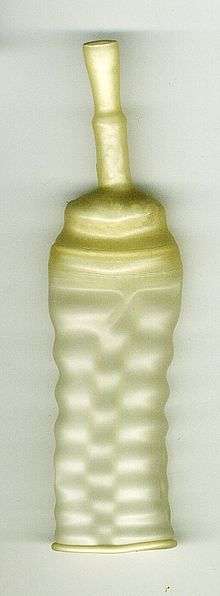External urine collection device
External urine collection devices are a type of medical product used, primarily by men, to manage urinary output and/or urinary incontinence. These devices attached to the outside of the penile area and direct urine into a separate collection chamber such as a leg or bedside bag. There are several varieties of external urine collection devices on the market today including male external catheters also known as urisheaths or Texas/condom catheters, urinals and hydrocolloid based devices.
External products should not be used by any individual who experiences urinary retention without overflow incontinence.
Types
Male external catheter

Male external catheters, urisheaths, Texas catheters or condom catheters are made of silicone or latex (depending on the brand/manufacturer) and cover the penis just like a condom but with an opening at the end to allow the connection to the urine bag. The sheath is worn over the penis. It stays in place by use of an adhesive, that can either be built in to the sheath or come as a separate adhesive liner. The urine gets funneled away from the body, keeping the skin dry at all times. The urine runs into a urine bag that is attached at the bottom of the external catheter. During the day, a drainable leg bag can be used, and at night it is recommended to use a large-capacity bedside drainage bag. Male external catheters are designed to be worn 24/7 and changed daily – and can be used by men with both light and severe incontinence. Male external catheters come in several sizes and lengths to accommodate anatomical variation.
It is very important that the male external catheter / urisheath fits well – both the diameter and the length. Different manufacturers have small measuring guides that can be used to measure what size is needed before ordering a sample. If you do not get measured correctly leakage and skin irritation can occur.
Studies[1] show that male external catheters /urisheaths combined with urine bags are preferred over absorbent products – in particular when it comes to ‘limitations to daily activities’. Advantages also include that they are discreet (it is easier to keep a personal matter that you are incontinent), your skin stays dry all the time (avoid skin irritation), and it is convenient to use both day and night. Potential complications can be increase in severity and frequency with long-term use. Up to 40% of condom catheter users will develop a urinary tract infection with long-term use.[2] Additionally, 15% of long term users will develop skin injuries including: inflammation, ulceration, necrosis, gangrene and constriction of the penis.[3] Additionally, sizing can prove difficult for some men, leading to dislodgement of the catheter and urine spillage during voiding (commonly referred to as pop-offs or blow-offs). Additionally, 1.3% of condom catheter users will develop a bladder or renal stone requiring medical treatment.[4]
Urinals
Urinals are a class of device which does not attach to the body. Instead, these external collection systems can be placed against the urinary opening during voiding and removed once voiding is complete. These are commonly used by hunters and sportsmen who may spend long periods away from a bathroom. These are not appropriate for men with urinary retention or who experience involuntary urine leakage.
See also
References
- ↑ 1. Chartier_kastler E et al.: Randomized, crossover study evaluating patient preference and the impact on quality of life of urisheaths vs. absorbent products in incontinent men, BJU Int. 2011 Jul; 08(2):241-7
- ↑ Ouslander, J., Greengold, B., Chen, S.,, “External Condom Catheter Use and Urinary Tract Infections Among Incontinent Male Nursing Home Patients” Journal of the American Geriatrics Society, Vol. 35, 1987.
- ↑ Golji, H., “Complications of External Condom Drainage,” Paraplegia (19), 1981.
- ↑ Stelling, J., RN, MSN, CRR, Hale, P., RN, BSN, CRRN, “Research update: clinically-derived protocol for changing condom catheters in males with spinal cord injury”, Pushin' On Newsletter, Vol 12[1]Winter, 1994. Access online: http://www.spinalcord.uab.edu/show.asp?durki=21450. May 19, 2011.